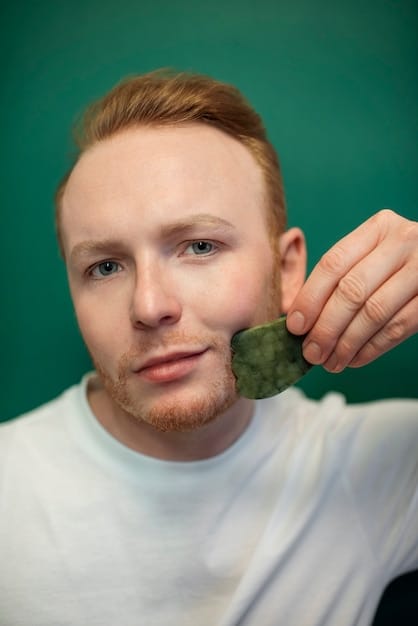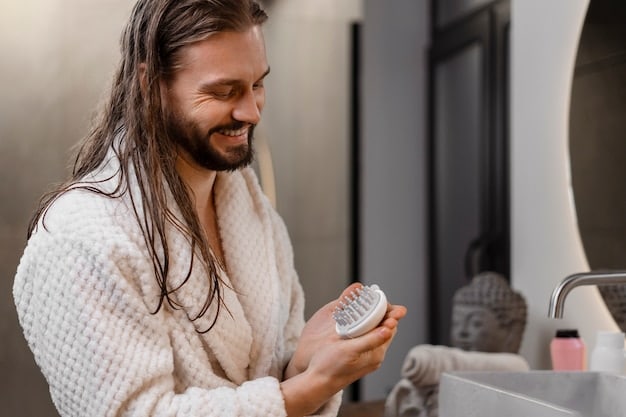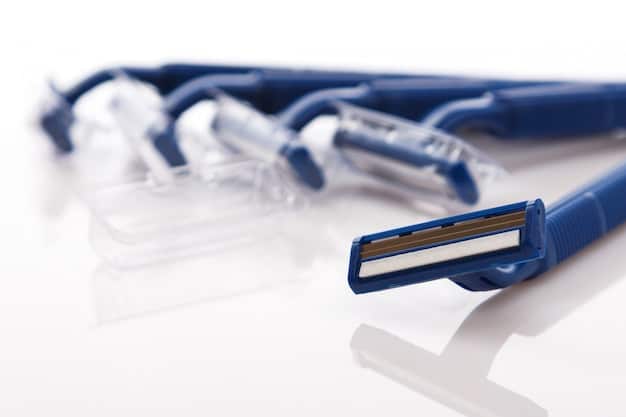How to Get a Perfect Shave: A Step-by-Step Guide

Achieving a perfect shave involves more than just running a razor over your face; it requires preparation, technique, and the right products to minimize irritation and maximize smoothness, ensuring a clean and comfortable result every time.
Want to achieve a flawlessly smooth shave every time? This step-by-step guide will teach you how to get a perfect shave every time, minimizing irritation and maximizing comfort.
Prepare Your Skin for the Perfect Shave
A great shave starts long before you even pick up a razor. Proper preparation softens the hair and protects your skin, setting the stage for a close and comfortable shave. Skipping this step can lead to irritation, razor burn, and a less-than-perfect result.
Exfoliate to Remove Dead Skin
Exfoliating before shaving removes dead skin cells, preventing them from clogging your razor and causing ingrown hairs. It also helps to lift the hairs, allowing for a closer shave.
Hydrate Your Skin
Hydrating your skin is crucial for softening the hair and making it easier to cut. Taking a warm shower or applying a hot towel to your face can help open up the pores and prepare your skin for shaving.
- Use a gentle scrub or exfoliating cleanser 2-3 times a week.
- Apply a pre-shave oil to further soften the hair and protect your skin.
- Avoid exfoliating too vigorously, as this can irritate your skin.
Properly preparing your skin turns the shaving process from challenging to a breeze, setting the stage for a flawless outcome.

Choose the Right Shaving Cream or Gel
The shaving cream or gel you use can significantly impact the quality of your shave. The right product will provide lubrication, protect your skin, and help the razor glide smoothly.
Consider Your Skin Type
Different skin types require different types of shaving creams or gels. If you have sensitive skin, look for products that are fragrance-free and hypoallergenic. For dry skin, choose a moisturizing cream that contains ingredients like shea butter or aloe vera.
Avoid Alcohol-Based Products
Alcohol-based shaving products can dry out your skin and cause irritation. Opt for creams or gels that are formulated with natural ingredients and contain moisturizing agents.
- Look for ingredients like aloe vera, shea butter, and vitamin E.
- Consider using a shaving brush to create a rich, lubricating lather.
- Experiment with different products to find the one that works best for your skin.
Choosing the right shaving cream or gel is a critical decision, ensuring both protection and a smooth glide for the razor.
Select the Best Razor for Your Skin
The type of razor you use plays a significant role in achieving a perfect shave. There are various options available, each with its own set of advantages and disadvantages. The key is to find a razor that suits your skin type and shaving style.
Cartridge Razors for Convenience
Cartridge razors are popular for their convenience and ease of use. They typically have multiple blades and pivoting heads that contour to the shape of your face. Look for razors with lubrication strips to further protect your skin.
Safety Razors for a Closer Shave
Safety razors offer a closer shave than cartridge razors, but they require more skill and practice to use properly. They have a single blade that exposes less of your skin to the razor, reducing the risk of irritation. Safety razors are also more environmentally friendly, as you only need to replace the blade, not the entire cartridge.
- Consider using a single-blade razor to minimize irritation.
- Replace your razor blade regularly to ensure a sharp, clean shave.
- Clean your razor after each use to prevent the buildup of bacteria and debris.
The right razor enhances the shaving experience, translating to smoother skin and reduced irritation, making it a crucial investment.

Master the Art of Shaving Technique
Even with the best products and tools, your shaving technique is incredibly important for achieving a perfect result. Proper technique minimizes irritation and ensures a close, comfortable shave.
Shave with the Grain
Always shave in the direction of hair growth (with the grain) to avoid irritation and ingrown hairs. This may not result in the closest shave possible, but it will significantly reduce the risk of skin problems.
Use Short, Gentle Strokes
Use short, gentle strokes, allowing the razor to do the work. Avoid pressing too hard, as this can cause irritation and razor burn. Rinse the blade frequently to remove hair and shaving cream.
- Stretch the skin taut with your free hand to create a smooth surface.
- Rinse the blade after every few strokes to prevent clogging.
- Avoid going over the same area multiple times, as this can lead to irritation.
Perfecting your shaving technique transforms mere shaving into an art form, enhancing comfort and reducing common skin issues.
Aftershave Care: Soothe and Protect
The post-shave routine is as important as the preparation and shaving itself. Proper aftershave care soothes, hydrates, and protects your skin, minimizing irritation and promoting healing.
Rinse with Cold Water
After shaving, rinse your face with cold water to close the pores and reduce inflammation. This helps to prevent bacteria from entering the pores and causing breakouts.
Apply Aftershave Balm or Lotion
Apply an aftershave balm or lotion to hydrate and soothe your skin. Look for products that contain ingredients like aloe vera, witch hazel, or chamomile. Avoid alcohol-based aftershaves, as they can dry out your skin and cause irritation.
- Pat your skin dry with a clean towel instead of rubbing.
- Apply a moisturizer to keep your skin hydrated throughout the day.
- Consider using a facial toner to balance your skin’s pH level.
Effective aftershave care calms irritation, hydrates the skin, and bolsters overall skin health, creating a lasting sense of freshness.
Dealing with Common Shaving Problems
Despite your best efforts, you may still encounter common shaving problems like razor burn, ingrown hairs, and bumps. Knowing how to address these issues can help you maintain smooth, healthy skin.
Razor Burn Relief
Razor burn is caused by irritation from the razor blade. To relieve razor burn, apply a cold compress to the affected area and use a soothing balm or lotion. Avoid shaving the area again until it has fully healed.
Preventing Ingrown Hairs
Ingrown hairs occur when hair curls back into the skin. To prevent ingrown hairs, exfoliate regularly and shave in the direction of hair growth. You can also use a product designed to treat and prevent ingrown hairs.
- Apply a warm compress to the affected area to help release the ingrown hair.
- Use tweezers to gently lift the ingrown hair, but avoid pulling it out completely.
- Consider laser hair removal or electrolysis for a permanent solution.
Addressing common shaving pitfalls ensures skin remains smooth and healthy, keeping your shaving routine consistently effective.
| Key Point | Brief Description |
|---|---|
| 🧼 Skin Prep | Exfoliate and hydrate before shaving to soften hair and protect skin. |
| 🧴 Shaving Cream | Choose a cream or gel suited to your skin type, avoiding alcohol-based products. |
| 🪒 Razor Choice | Select the best razor based on skin sensitivity and shaving goals. |
| 🚿 Aftercare | Rinse with cold water and apply aftershave balm to soothe and protect. |
Frequently Asked Questions
▼
Replace your razor blade every 5-7 shaves to ensure a sharp, clean shave and minimize irritation. Dull blades can cause razor burn and increase the risk of ingrown hairs.
▼
Shaving in the morning allows your skin to recover during the day, while shaving at night gives you a smoother start. Choose the time that fits best with your schedule and skin’s needs.
▼
Yes, hair conditioner can be used as a substitute for shaving cream. It provides lubrication and helps the razor glide smoothly, but it may not offer the same level of protection as shaving cream.
▼
To prevent razor burn, ensure you prep your skin properly, use a sharp razor, shave with the grain, and apply a soothing aftershave balm. Avoid pressing too hard with the razor.
▼
Exfoliating regularly, shaving in the direction of hair growth, and using a product designed to treat ingrown hairs can help. A warm compress can also assist in releasing the hair.
Conclusion
Achieving the perfect shave involves a combination of proper preparation, technique, and aftercare. By following these steps and addressing common shaving problems, you can enjoy a smooth, comfortable, and irritation-free shave every time.





